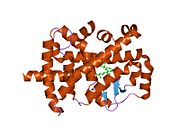RAR-related orphan receptor beta
Ensembl | |||||||||
|---|---|---|---|---|---|---|---|---|---|
| UniProt | |||||||||
| RefSeq (mRNA) | |||||||||
| RefSeq (protein) | |||||||||
| Location (UCSC) | Chr 9: 74.5 – 74.69 Mb | Chr 19: 18.91 – 19.09 Mb | |||||||
| PubMed search | [3] | [4] | |||||||
| View/Edit Human | View/Edit Mouse |
RAR-related orphan receptor beta (ROR-beta), also known as NR1F2 (nuclear receptor subfamily 1, group F, member 2) is a nuclear receptor that in humans is encoded by the RORB gene.[5]
Function
The protein encoded by this gene is a member of the NR1 subfamily of nuclear hormone receptors. It is a DNA-binding protein that can bind as a monomer or as a homodimer to
In the brain, ROR-beta is concentrated in layer 4 of the cerebral cortex, where it plays a role in the development of structures such as barrel columns.[7]
A mutation in this gene also results in the loss of spinal cord interneurons and of saltatorial locomotion,[8] a type of hopping gait that in mammals can be found in rabbits, hares, kangaroos, and some species of rodents.
Interactions
RAR-related orphan receptor beta has been shown to
See also
References
- ^ a b c GRCh38: Ensembl release 89: ENSG00000198963 – Ensembl, May 2017
- ^ a b c GRCm38: Ensembl release 89: ENSMUSG00000036192 – Ensembl, May 2017
- ^ "Human PubMed Reference:". National Center for Biotechnology Information, U.S. National Library of Medicine.
- ^ "Mouse PubMed Reference:". National Center for Biotechnology Information, U.S. National Library of Medicine.
- PMID 7926749.
- ^ "Entrez Gene: RORB RAR-related orphan receptor B".
- PMID 21799210.
- PMID 33764968.
- PMID 8858107.
Further reading
- Beeson WM, Perry TW, Zurcher TD (1977). "Effect of supplemental zinc on growth and on hair and blood serum levels of beef cattle". J. Anim. Sci. 45 (1): 160–5. PMID 885817.
- Carlberg C, Hooft van Huijsduijnen R, Staple JK, DeLamarter JF, Becker-André M (1994). "RZRs, a new family of retinoid-related orphan receptors that function as both monomers and homodimers". Mol. Endocrinol. 8 (6): 757–70. S2CID 22342101.
- Greiner EF, Kirfel J, Greschik H, Dörflinger U, Becker P, Mercep A, Schüle R (1996). "Functional analysis of retinoid Z receptor beta, a brain-specific nuclear orphan receptor". Proc. Natl. Acad. Sci. U.S.A. 93 (19): 10105–10. PMID 8816759.
- Paravicini G, Steinmayr M, André E, Becker-André M (1996). "The metastasis suppressor candidate nucleotide diphosphate kinase NM23 specifically interacts with members of the ROR/RZR nuclear orphan receptor subfamily". Biochem. Biophys. Res. Commun. 227 (1): 82–7. PMID 8858107.
- Bonaldo MF, Lennon G, Soares MB (1996). "Normalization and subtraction: two approaches to facilitate gene discovery". Genome Res. 6 (9): 791–806. PMID 8889548.
- Park HT, Baek SY, Kim BS, Kim JB, Kim JJ (1996). "Developmental expression of 'RZR beta, a putative nuclear-melatonin receptor' mRNA in the suprachiasmatic nucleus of the rat". Neurosci. Lett. 217 (1): 17–20. PMID 8905729.
- André E, Conquet F, Steinmayr M, Stratton SC, Porciatti V, Becker-André M (1998). "Disruption of retinoid-related orphan receptor beta changes circadian behavior, causes retinal degeneration and leads to vacillans phenotype in mice". EMBO J. 17 (14): 3867–77. PMID 9670004.
- Greiner EF, Kirfel J, Greschik H, Huang D, Becker P, Kapfhammer JP, Schüle R (2000). "Differential ligand-dependent protein-protein interactions between nuclear receptors and a neuronal-specific cofactor". Proc. Natl. Acad. Sci. U.S.A. 97 (13): 7160–5. PMID 10860982.
- Gawlas K, Stunnenberg HG (2000). "Differential binding and transcriptional behaviour of two highly related orphan receptors, ROR alpha(4) and ROR beta(1)". Biochim. Biophys. Acta. 1494 (3): 236–41. PMID 11121580.
- Gawlas K, Stunnenberg HG (2001). "Differential transcription of the orphan receptor RORbeta in nuclear extracts derived from Neuro2A and HeLa cells". Nucleic Acids Res. 29 (16): 3424–32. PMID 11504880.
- Stehlin C, Wurtz JM, Steinmetz A, Greiner E, Schüle R, Moras D, Renaud JP (2001). "X-ray structure of the orphan nuclear receptor RORbeta ligand-binding domain in the active conformation". EMBO J. 20 (21): 5822–31. PMID 11689423.
- Sumi Y, Yagita K, Yamaguchi S, Ishida Y, Kuroda Y, Okamura H (2002). "Rhythmic expression of ROR beta mRNA in the mice suprachiasmatic nucleus". Neurosci. Lett. 320 (1–2): 13–6. S2CID 54411407.
- Stehlin-Gaon C, Willmann D, Zeyer D, Sanglier S, Van Dorsselaer A, Renaud JP, Moras D, Schüle R (2003). "All-trans retinoic acid is a ligand for the orphan nuclear receptor ROR beta". Nat. Struct. Biol. 10 (10): 820–5. S2CID 10108247.
External links
- orphan+nuclear+receptor+ROR-beta at the U.S. National Library of Medicine Medical Subject Headings (MeSH)



